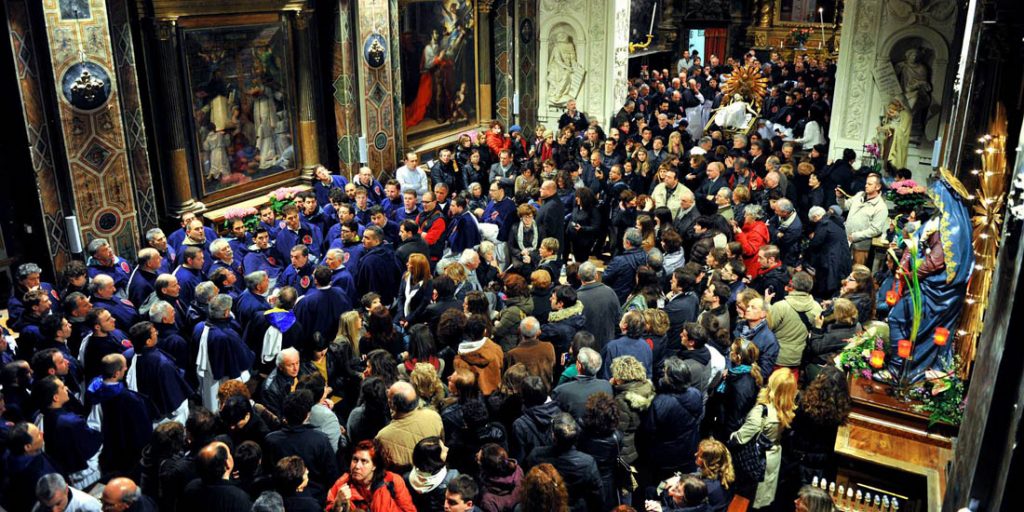THE CONFRATERNITY OF SANTA CROCE
The venerable Confraternity of Santa Croce is an important testimony of the lay movement that characterised the second millennium with the creation of Confraternities. Over the centuries such associations saw a consistent number of people involved within their activity for various reasons - i.e. religious (cult, suffrage), charitable (helping the sick, dowries for spintsters). It is therefore easy to understand the value that such initiatives assume whitin civil society by promoting camaraderie among men and leading to class fusion, carrying out charity work and aid, contributing tu Christian life renewal with more intense spirituality supported
by acts of charity towars other people
With the post-unitary legislation, as the secularisation process of charity work continued and public assistance came into being, religious associations lost a great deal of their power and appeal. Currently, of that world once so important and quaint, nothing remains but the memory of the striking processions that took place at night and just before dawn breaking, along with great works of art preserved in churches and oratories.
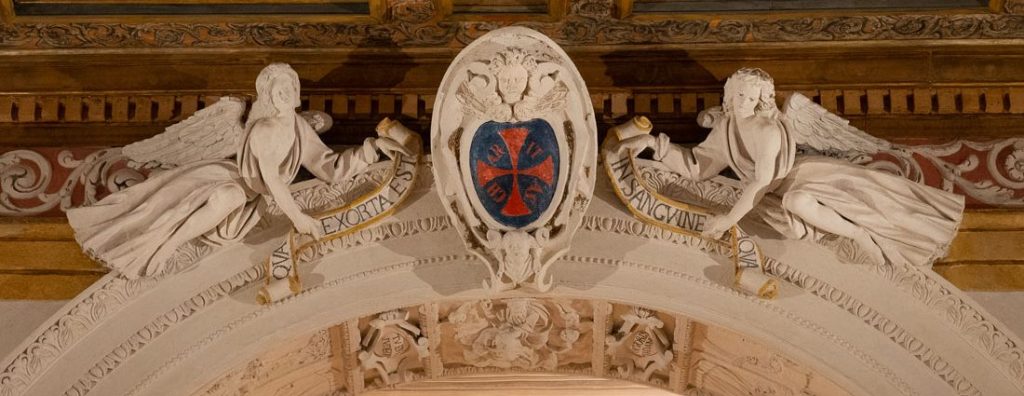
In fact Confraternities carried out an important role in development of art and literature, painting and music, Confraternities influenced art, because chapels and oratories were embellished by painters and sculptors, and music, because lauds were not read but sung. Confraternities also influenced civil life as religious aspects blended qith profane ones in the frequent references to daily life from which the authors often took their cue.
In Gubbio the Confraternity of Santa Croce della Foce is the only one still existing.
Civilly recognised as an Ecclesiastical Body with Royal Decree N. 1095 (N.33 - 6 july
1933), it is a legal entitny enrolled in the Register of Legal Persons of the Court of Perugia. Its status approved by the Ecclesiastical Authority, it was reformed after circa sixty years of inactivity in 1987.
The Confraternity clothing - i.e. cappa (cape) which Italian refers to as sacchi (sacks) or sacconi (big sacks) - became one of the main identifying symbols of the associations, and is still so. All The sacchi must have the buffa - (i.e. hood) - a sign of humbleness and hiding. When hoods cover faces, recognition is not possible, thes indicating the anonymity of good deeds and erasing social class difference.
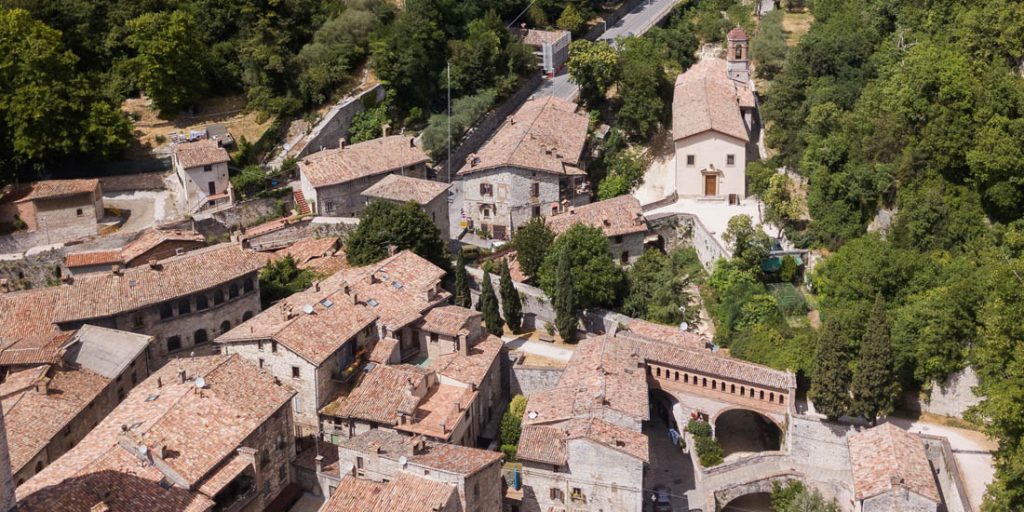
THE ORIGINS
The origins of our Confraternity date back long ago. It originales, as all the others, from Compagnie dei Disciplinati (i.e. self-flagellant confraternities) that came together with Compagnie dei Laudesi in day-to-day life - the latter acting aut the Church sacred plays of mysteries, above all Christ Passion in town squares. Portrayals were organised by Confraternities, such as ours, stemming from cult and suffrage aims.
THE AIMS
Among the Confraternity mains, aims, in addition to those more closely linked to the cult of the Cross and the Most Holy Virgin under the title of the Carmelo,were those of suffrage, accompaniment and burying of the deceased. Article 11 of the
new Statute states the Confraternity aiims - i.e. Protecting the Churh of Santa Croce and safeguarding and increasing its liturgical patrimony; being present and favouring maximum participation of the faithful in the “Processione del Cristo Morto” (Dead Christ Procession); helping to keep up the devoted, pious traditional hymm “Miserere”; celebrating the festival of the Madonna of Carmelo, the Exaltation of Santa Croce, and solemnising all other services or ceremonies held in the Confraternity Church.
Such are tasks that the Brothers still fulfil with as particular dedication as they would in past centuries. Their effort into the Church restoration and organisation of the Holy Week and Good Friday Procession is an example to all.
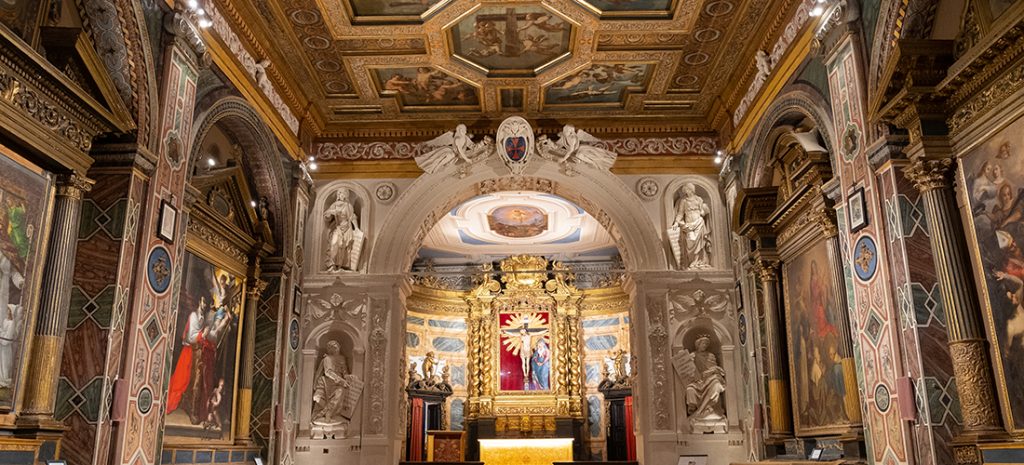
THE DEAD CHRIST PROCESSION
The Dead Christ Procession, one of the most important religious events in our town, is what is left of the scenic portrayals of plays organised in town squares in the XIII century to make liturgies celebrated in church come to life, notably over the Holy Week. Sacred plays such as the Nativity (Greggio nativity scene), the Three Kings’ arrival, the Passion and Resurrection were thus represented. The Passion was certainly the most frequently represented play, due to the scenery complexity and strong emotions (See La Turba - The Crowed - Good Friday miracle play in Cantiano). The representations would end with a vanity fire (i.e. amulets, masks, etc. were burned).
The Holy Representation takes place on Good Friday late afternoon leavin from Santa Croce Church, following an ancient route that allowed the Dead Christ to be “displayed” at the veneration of monasteries, convents, confraternities and hospitals.
It is worth noting the number of stops: at the “pietrone”; at San Domenico Church, where it takes part in the Procession of Bishopo and Clergy; at the hospital and, up until the early XX century, ather, other stops were envisdaged at the Borgo delle Cappuccine, in the Churches of the Monasteries of San Pietro, S.Spirito, and San Marziale.
It was Bishop Giovan Battista Nasalli Rocca who, in agreement with civil authorities, writing to the Confraternity Prior in 1916 stated that the procession should begin at 6pm “so that it will not go onto the night”. He provided indications and recommendations: “the disgrace of the drinker should be avoided” and “for greater brevity only the stops at San Pietro and San Domenico Churches should be allowed”. It was evident that the numerous stops at churches caused considerable delays and allowed those carrying the baldachin to “wet their whistlse in continuation”.
The procession sequence follows an ancient protocol (on which some documents may be found in the Archives of the Rectory of San Secondo, in whose parish the Church of Santa Croce della Foce fell within until 1970, or in the Bishops’ Archives, as Prelates would always pay particular attention to such popular faith manifestation) providing for indicasions and suggestions, as well as prohibitions.
True dramatic representation, the procession starts with four Brothers playing the battistrangole, followed by the skull carrier. Then come the three Cavalry Crosses, the large Tree of Life Cross (also known as the “Trunk” for its recerence to he Holy Scriptures), the two radial Crosses, emblems of the Compagnia del Crocifisso (Company of the Crucifix) and Compagnia del Carmelo (Company of the Carmelo).
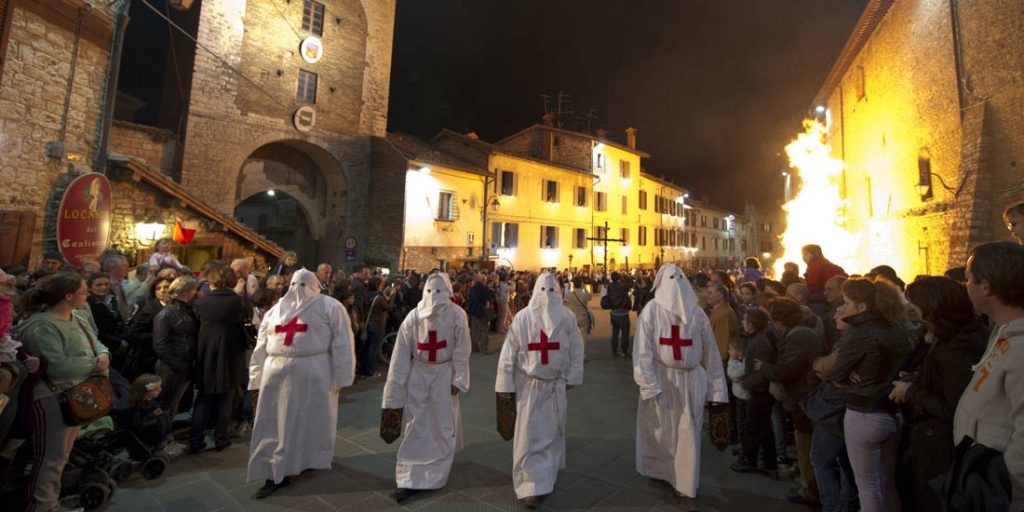
Furthermore there are alla the Passion symbols: the cup, the thirty silver coins, the column, the rooster, the crown of thorns, “Pilate’s basin”, the writing I.N.R.I., Veronica’s veil, the shroud, the nails, the hammer, the sponge, the spear, Jesus’ clothing, the dice, the ladder, and the pincer. The Procession continues with large torches provided the Municipality, the Arts and Crafts Corporations and various citizens associations that proceed just before Clergy and Bishop. Then comes the image of the Dead Christ on the cataletto, covered with a preciosu baldachin and the statue of Our Lady of Sorrows on particular radial processional equipment. The two holy images are accompanied by the singing of the Miserere, King David’s penitential psalm whose palyphonic melody was passed down to us through oral tradition. We do no know how distant the origin of the Miserere chorus dates back, although the musical structure of the hymn recalls a composition from early XIX century. In the Archives, Miserere is never quoted in the procession composition before 12 March 1895, when the Confraternity Prior, in giving indication for the
Procession with public manifesto, quoted “the cantors of the harmonious Miserere”. In a “Notification for the solemn Procession of the Dead Christ” on 25 March 1911 Bishop Nasalli Rocca also provided for as follows: “A choir of cantors, all dressed in capes, under the guidance of a priest appointed by the Santa Croce Venerable Confraternity, will sing the Miserere quietly, solemnly and gracefully. It remains forbidden for others outside this group, not dressed in capes and not appointed by the Confraternity, to sing any prayers of hymns”.
Remarkable public participation follows the images of Christ and Virgin Mary.
When the Procession touches various sites of the town, focaroni or torticci are lit. It si an anciente, still valid tradition, notably in Via Dante, because of the effective suggesion it brings along. Fire is the best purifyng element: it is at the same time personale and communitarian participation in the redeeming event being celebrated.
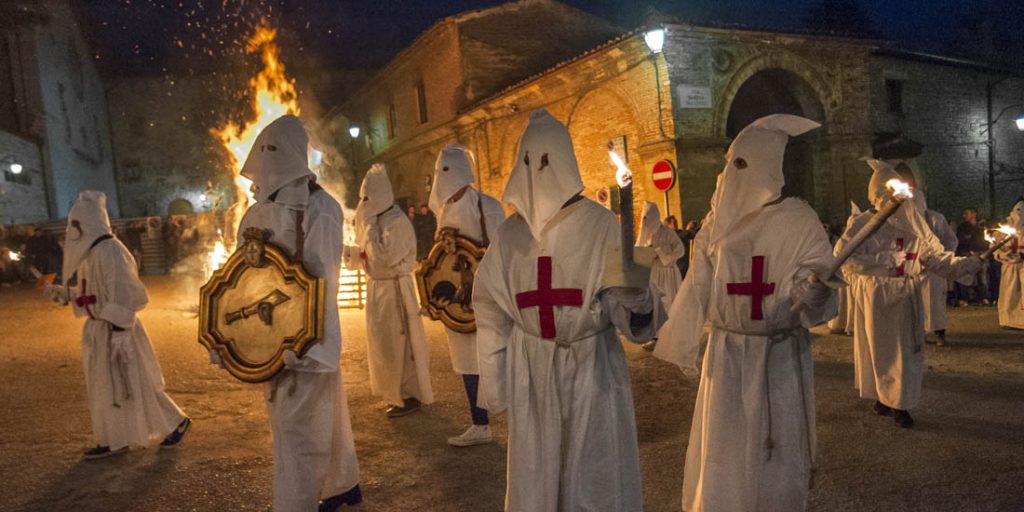
The shrill sound of the battistrangole, the choirs tormenting notes, the fires and torches, the people devotion and the incomparable scenery of the town bring a deeply suggestive climate to the event, particularly appreciated by the numerous tourist participating in the mystic procession, one of the greates identities survived in our town until the present day.
The long procession - at times silent, in other moments full of prayer or attentive listening to the mournful plea for forgiveness sung by the Miserere choirs, along a route covering the whole city - ends up in San Domenico Church with the Bishop’s sermon. Finally, the Holy Images are taken back to Santa Croce Church and exhibited to the faithul, while the two choirs continue to sing, alternating all the verses of the Miserere.
A particularly heartfelt tradition is the “Kiss of the Dead Christ” whit the offer of violets. It begins on Goo Friday morning, it obviously suspended throughout the
Procession duration, and starts again fo the whole of Saturday. A continuous flow of people always occurs, often coming from the most isoladed places in the countryside. For many of them, this would once be one of the few occasions to come to Gubbio; some would participate in the Procession carryng a large candle. All the area around the Church gets busy due to the large number of people present; the tradition of the ciambella remains, sold in the shops along Via Gabrielli, to the joy above all of the children who hook them on their arms.
The ritual of the Repositioning of Christ is a touching ceremony performed in the same Church ad 9.00 pm on Holy Saturday. The Church rector, aieded by the Broters, places Christ on the Cross of the main altar niche, inserting three nails in the qounds in Christ’s hands and feet, bound together. Christ statue, as we will see later, has untied arms, thus being venerated as Crucifixion or Deposition.
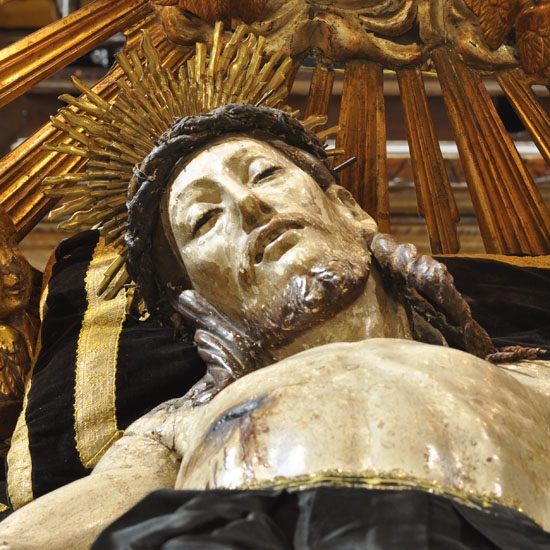
TWO SACRED IMAGES OF THE PROCESSION
THE CRUCIFIX
Jesus’ death on the Cross constitutes the cornerston image of Christian iconography and the basis of religious contemplation. Our Crucifix is a powerful, impressive polychrome wooden structure from the sixteenty century, which tradition requires be sculpted from a single fig tree trunk with untied arms to thus transform the Crucifixion image into a Deposition image.
Jesus is shown dyning with his head leaning on his right shoulder (John 19:30, “With that, he howed his head and gave up his spirit”). The intense object displays the truly exceptional care taken in details: the crown oh thorns is added in leather, as is the lock of hair hanging down His left shoulder; His other hair is sculpted, as is His beard; His half-open mouth with teeth and half-closed eyes; highlighted anatomy of bones and muscles.
The black marks surrounding the wounds in Christ’s hands, feet and sides are due to the use of balm, an ancient custom surviving in our Church until early XX century and whose tradition is still alive in nearby Cantiano and Cagli - i.e. puttin cotton wool embedded in balm (a sweet-smelling resinous substance) into the Christ’s wounds to then remove flakes for devotion. Several studies into the origin of the sculpture are currently being performed. So far they have not been backed up by documentation, but research is concentrating on the workshop in Sansepolcro by Romano Alberti, known as the “Nero”. Several works by this “excellent carver” are well-known, such as a Crucifix in the Church of Santa Maria delle Grazie in Rivaio di
Castiglion Fiorentino (1952), which displays very strong analogies to our venerated image - i.e. the overall shaping, alike somatic and expressive features of the two sculptures, half-closed eyes, half-open mouth, and even loincloth drapery are so similar that the two works seem to be a single artefact. Nero Alberti opened a workshop mid-XVI century in Sansepolcro, where he produced numerous staues for purchsers from Umbria, Tuscany and the Marche. The Crucifix in the Confraternity Church of San Giuseppe in Cagli, often compared to the Crucifix in Santa Croce, can be attributed to the same artist.
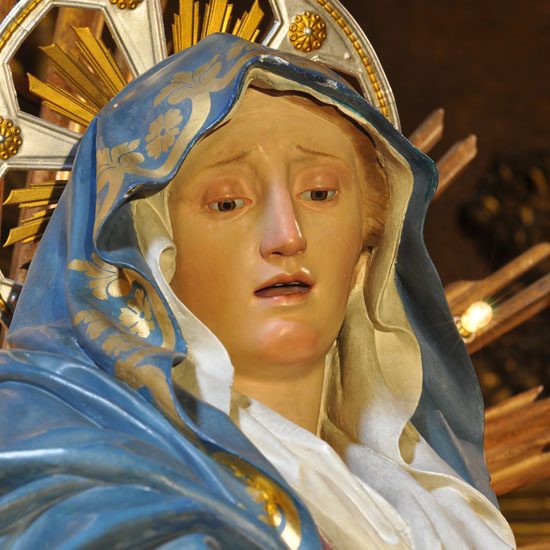
OUR LADY OF SORROWS
The papier-mâché statue was acquired by the Confraternity in the first half of the XIX century. It is certainly a beautiful composition chowing traces of XIX century romantic pietism. Thanks to stylistic comparison (see the Cathedral in Ferrara and Sant’ Alberto Church in Ravenna), we can certainly affirm the work came from the Ballanti-Graziani workshop in Faenza. The choice may have been due to the presence of Tommaso Minardi in Gubbio and Santa Croce - famous painter from Faenza, and friend and frequent visitor to the Ballanti family. The creator oh the statue iconographic invention is unknown, although in Faenza the image was very common and frequently reproduced in the first half of the XIX century on palychrome majolica plates.
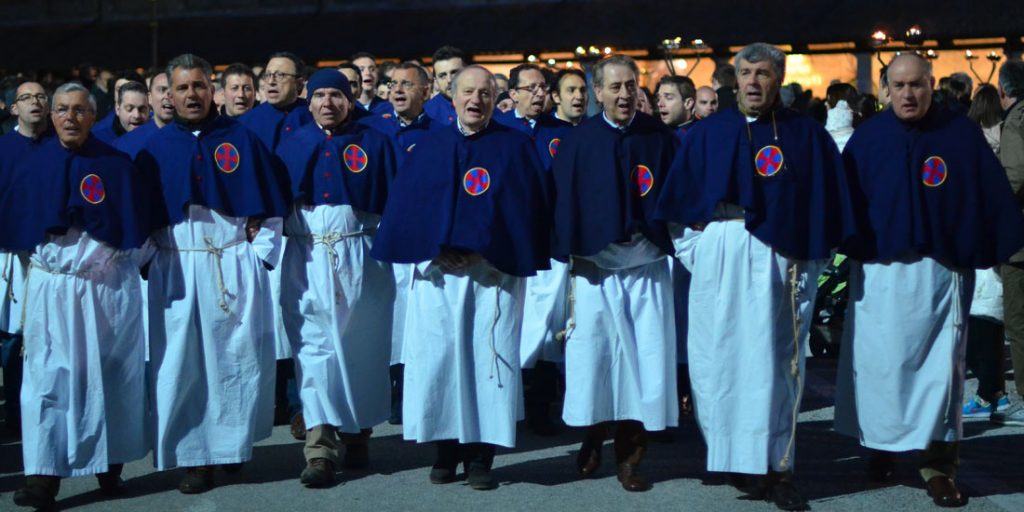
MISERERE
Miserere is one of the seven penitential psalms of Catholic liturgy (N. 50 of Vulgate - N. 51 of the Hebrew version).
Written and recited by King David around the year 1000 B.C., the psalm begins with “Miserere mei Deus” (i.e.” Mercy on me, oh Lord) and narrates King David’s meeting whit prophet Nathan, who reproaches him for committing a twofold sin, namely his adultery with Betsabea and her husband’s murder. King David invokes and praises God’s mercy,trusting in his forgiveness. Miserere is recited on the occasion of divine offices, liturgical rituals (i.e. funerary) and pious penitential exercises.
Over centuries, high spiritual meditations and most appreciated poetical and music compositions were inspired to Miserere dramatic text.
Legacy of the Middle Age sacred dramaturgy, the Miserere hymm in Latin has always been ever passed down by Gubbio inhabitants. Miserere accompanies Jesus Christ Passion symbols, as well as the workshiped Dead Christ and our Lady of Sorrows’ statues along the Procession held on Good Friday by the S.Croce della Foce Confraternity. In ancient times, Miserere was alternately sung by two groups, most probably represented by chorus and people respectively.
Nowadays only uneven numbered strophes are sung as, over time, musical memory of the other has been lost.
